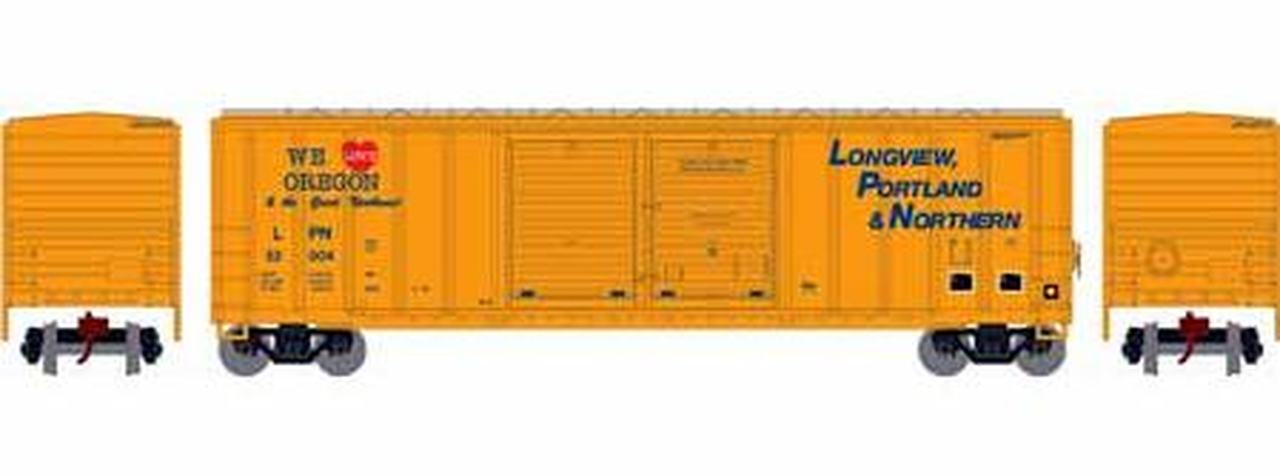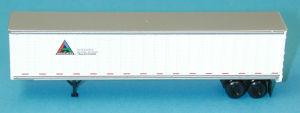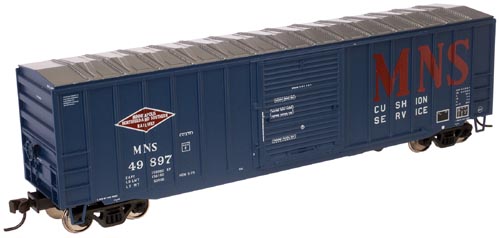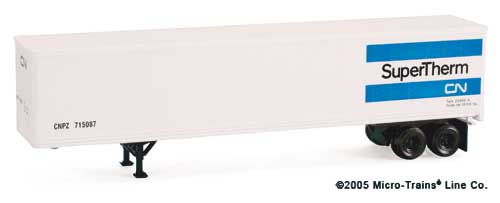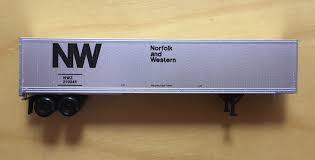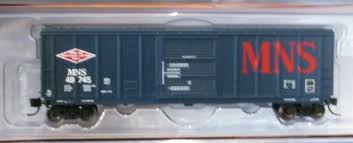Model Information: Boxcar, 50 Foot, Offset Double Sliding Door, Rib Side, Without Roofwalk, FMC. Originally designed by MDC Roundhouse, this tooling was acquired by Athearn in June of 2004. It has since been re-released with Accumate and/or McHenry couplers. This body style has two doors offset from center of the car.
Current versions features: Scale profile brake wheel; Roller bearing trucks; Fully-assembled and ready-to-run out of the box; Accurately painted and printed; Highly detailed, injection molded body; Machined metal wheels; Screw mounted trucks; McHenry knuckle couplers; Weighted for trouble free operation; Clear plastic jewel box for convenient storage; Operates on Code 55 and 80 rail; Minimum radius: 9-3/4".
Current versions features: Scale profile brake wheel; Roller bearing trucks; Fully-assembled and ready-to-run out of the box; Accurately painted and printed; Highly detailed, injection molded body; Machined metal wheels; Screw mounted trucks; McHenry knuckle couplers; Weighted for trouble free operation; Clear plastic jewel box for convenient storage; Operates on Code 55 and 80 rail; Minimum radius: 9-3/4".
Prototype History: In the 1970's with the growth of the Per Diem business model, FMC produced a series of 50 foot box cars in different configurations. The single-sliding-door configuration is one of the best known and used widely by many different railroads. These cars were produced using the Gunderson metal works which FMC had acquired in 1965. In late 1975, FMC began producing a 5,077-cubic-foot Plate B box car for IPD and Railbox service. FMC's 5077s have seven panels to either side of the 10-foot door, an X-panel roof, and non-terminating ends that are slightly different from those used on FMC's earlier cars. Note how the sidesill is notched all the way back to the bolsters, a key feature of FMC's mature design.
The main difference between the 5077 cu. ft cars built by FMC vs the 5277-5347 cu. ft cars built by the same manufacturers is the overall height of the car, the smaller 5077 cars were Plate B while the larger 5277-5347 cars were Plate C. Over 4,300 cars were produced from 1975-1979 by FMC's Portland, Oregon plant. The cars were delivered in numerous colorful shortline paint schemes, as well as the nationwide car pool fleet of Railbox. Many secondhand cars were later seen in Class 1 railroads and large leasing company fleets under additional shortline reporting marks.
The main difference between the 5077 cu. ft cars built by FMC vs the 5277-5347 cu. ft cars built by the same manufacturers is the overall height of the car, the smaller 5077 cars were Plate B while the larger 5277-5347 cars were Plate C. Over 4,300 cars were produced from 1975-1979 by FMC's Portland, Oregon plant. The cars were delivered in numerous colorful shortline paint schemes, as well as the nationwide car pool fleet of Railbox. Many secondhand cars were later seen in Class 1 railroads and large leasing company fleets under additional shortline reporting marks.
Road Name History: 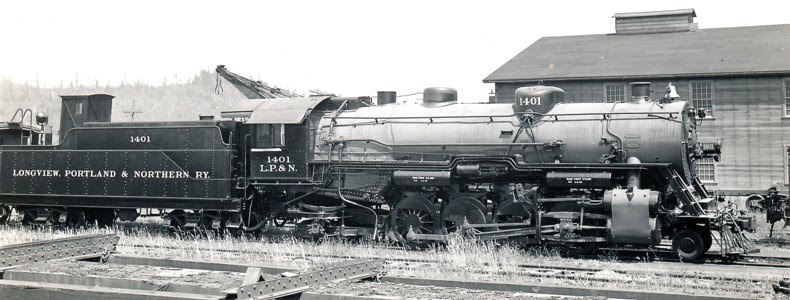 The original 30 mile LP&N route was built between Longview Junction and Ryderwood, Washington in 1929 by and for a local timber magnate named Long (who also founded the city of Longview.) In 1952, he built a second, separate 4 mile line in the Gardener, Oregon area and abandoned the original Ryderwood line the following year. In 1955, he bought another separate logging line from Spaulding-Miami Lumber Company between Willamina and Grand Ronde. In 1960, he expanded again, buying the 33 mile Northern Pacific line between Rye Junction and Chelatchie, Washington. Each separate segment was operated as part of the Longview Portland & Northern Railway. Things remained relatively consistent for the next 20 years. Then in 1980, the former logging line was sold to become the Willamina & Grand Rond Railway. The following year, the former Northern Pacific line was sold to form the Chelatchie Prairie Railroad. The last remaining segment, the 4 miles to Gardiner, closed in 1999 when the sawmill it served closed.
The original 30 mile LP&N route was built between Longview Junction and Ryderwood, Washington in 1929 by and for a local timber magnate named Long (who also founded the city of Longview.) In 1952, he built a second, separate 4 mile line in the Gardener, Oregon area and abandoned the original Ryderwood line the following year. In 1955, he bought another separate logging line from Spaulding-Miami Lumber Company between Willamina and Grand Ronde. In 1960, he expanded again, buying the 33 mile Northern Pacific line between Rye Junction and Chelatchie, Washington. Each separate segment was operated as part of the Longview Portland & Northern Railway. Things remained relatively consistent for the next 20 years. Then in 1980, the former logging line was sold to become the Willamina & Grand Rond Railway. The following year, the former Northern Pacific line was sold to form the Chelatchie Prairie Railroad. The last remaining segment, the 4 miles to Gardiner, closed in 1999 when the sawmill it served closed.

Brand/Importer Information: Athearn's history began in 1938, when its founder-to-be, Irvin Athearn, started an elaborate O scale layout in his mother's house. After placing an ad selling the layout, and receiving much response to it, Irv decided that selling model railroads would be a good living. He sold train products out of his mother's house through most of the 1940s. After becoming a full-time retailer in 1946, Irv opened a separate facility in Hawthorne, California in 1948, and that same year he branched into HO scale models for the first time.
Athearn acquired the Globe Models product line and improved upon it, introducing a comprehensive array of locomotive, passenger and freight car models. Improvements included all-wheel drive and electrical contact. One innovation was the "Hi-Fi" drive mechanism, employing small rubber bands to transfer motion from the motor spindle to the axles. Another was the double-ended ring magnet motor, which permitted easy connection to all-wheel-drive assemblies. Athearn was also able to incorporate flywheels into double-ended drives.
The company produced a model of the Boston & Maine P4 class Pacific steam locomotive which incorporated a cast zinc alloy base and thermoplastic resin superstructure. It had a worm drive and all power pickup was through the bipolar trucks that carried the tender. This item was discontinued after the Wilson motor was no longer available, and was not redesigned for a more technologically advanced motor.
Athearn's car fleet included shorter-than-scale interpretations of passenger cars of Southern Pacific and Atchison, Topeka & Santa Fe Railroad prototypes. The company also offered a variety of scale-length freight cars with sprung and equalized trucks. The cars could be obtained in simple kit form, or ready-to-run in windowed display boxes. The comprehensive scope of the product line contributed to the popularity of HO as a model railroad scale, due to the ready availability of items and their low cost.
Irv Athearn died in 1991. New owners took control in 1994, but continued to follow Athearn's commitment to high-quality products at reasonable prices. Athearn was bought in 2004 by Horizon Hobby. Athearn was then moved from its facility in Compton to a new facility in Carson, California. In mid-2009, all remaining US production was moved to China and warehousing moved to parent Horizon Hobby. Sales and product development was relocated to a smaller facility in Long Beach, California.
Read more on Wikipedia and Athearn website.
Athearn acquired the Globe Models product line and improved upon it, introducing a comprehensive array of locomotive, passenger and freight car models. Improvements included all-wheel drive and electrical contact. One innovation was the "Hi-Fi" drive mechanism, employing small rubber bands to transfer motion from the motor spindle to the axles. Another was the double-ended ring magnet motor, which permitted easy connection to all-wheel-drive assemblies. Athearn was also able to incorporate flywheels into double-ended drives.
The company produced a model of the Boston & Maine P4 class Pacific steam locomotive which incorporated a cast zinc alloy base and thermoplastic resin superstructure. It had a worm drive and all power pickup was through the bipolar trucks that carried the tender. This item was discontinued after the Wilson motor was no longer available, and was not redesigned for a more technologically advanced motor.
Athearn's car fleet included shorter-than-scale interpretations of passenger cars of Southern Pacific and Atchison, Topeka & Santa Fe Railroad prototypes. The company also offered a variety of scale-length freight cars with sprung and equalized trucks. The cars could be obtained in simple kit form, or ready-to-run in windowed display boxes. The comprehensive scope of the product line contributed to the popularity of HO as a model railroad scale, due to the ready availability of items and their low cost.
Irv Athearn died in 1991. New owners took control in 1994, but continued to follow Athearn's commitment to high-quality products at reasonable prices. Athearn was bought in 2004 by Horizon Hobby. Athearn was then moved from its facility in Compton to a new facility in Carson, California. In mid-2009, all remaining US production was moved to China and warehousing moved to parent Horizon Hobby. Sales and product development was relocated to a smaller facility in Long Beach, California.
Read more on Wikipedia and Athearn website.
Item created by: gdm on 2019-01-30 09:10:29
If you see errors or missing data in this entry, please feel free to log in and edit it. Anyone with a Gmail account can log in instantly.
If you see errors or missing data in this entry, please feel free to log in and edit it. Anyone with a Gmail account can log in instantly.


